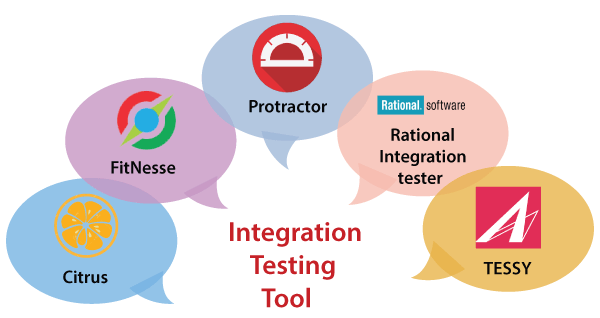Integration testing tools are used to test the interface between modules and find the bugs; these bugs may happen because of the multiple modules integration. The main objective of these tools is to make sure that the specific modules are working as per the client's needs. To construct integration testing suites, we will use these tools.
Some of the most used integration testing tools are as follows:
- Citrus
- FitNesse
- TESSY
- Protractor
- Rational Integration tester

Citrus
It is the most commonly used integration testing tool, which is a test framework and written in the Java programming language. It is used to take the request and respond to both server-side and client-side. It is used to authenticate the XML, JSON files. It supports multiple protocols such as HTTP, JMS, and SOAP to achieve end-to-end use case testing.

Feature of Citrus
- It is both an open-source and a licensed tool; that's why it provides a low-cost solution.
- Citrus is used to send and receive messages.
- With the help of this tool, we can validate the database.
- It will describe the sequence of messages.
- Error replication.
- It produces the message and authenticates responses.
- It will use the advance logic in test cases.
- It provides the test plan and documents the test coverage.
FitNesse
It is an open-source tool that does not need separate installation, we need to download the java jar file, and we can use it directly. It is written in Java language and supports another programming language such as Python, C++, C#, Ruby, and so on.
With the help of this tool, we can get a quick response from the users.

Features of FitNesse
- It is used to verify the needs of the actual software application for any software project.
- It is used to run the test and match the real output to the expected output.
- With the help of this tool, we can easily use the wiki web server.
- It also supports an agile style of black-box testing, regression, and acceptance testing.
TESSY
It is an essential tool for integration testing that is used to execute the integration and unit testing for the embedded software. It will take care of the whole test organization along with the requirements, traceability, test management, and the coverage measurement.
TESSY helps us to find the code coverage of an application. With the help of CTE (classification of tree editor), we can design the test cases. And we can edit the test data by using TDE (test data Editor).

Features of TESSY
Following are the standard features of TESSY tool:
- It has the floating license application rights
- The three primary functions of TESSY are TIE (Test interface Editor), TDE (Test Data Editor), and workspace.
- It is used to analyze the interface of the function and defines the variable used by that function.
- TESSY supports C++ and C programming languages.
- For the test execution results, it creates the test report.
Protractor
It is an open-source end-to-end testing framework, which is designed for the AngularJS and Angular application, and written in JavaScript. It is a NodeJS program that is used to find the web elements in the AngularJS applications. Once the application is running in a real browser, it will execute the tests against our application.

Features of Protractor
- With the help of Protractor, we can execute the instance of our application.
- It is used for integration testing.
- From the end-users point of view, it performs the tests.
- It is used to write the end-to-end test.
- It is used for dynamic web applications.
Rational Integration Tester
Previously it is known as a Green hat, but now it is acquired by IBM and known as rational integration tester. It gives the scripting free environment for developing business process integration projects and tests for SOA messaging. It belongs to a rational test workbench.
This tool provides the cost-productive test environments that enable clients to test application early during the development life cycle. With the help of this tool, we can avoid the integration issues by using iterative and agile development process.

Features of Rational Integration Tester
- It will allow us to perform integration, functional, and regression testing.
- If some modules are missing, but the testing will continue, generates code and reusable stubs.
- It will provide the recording facilitating, which upload and export from rational integration tester to the rational test control panel.
- In this, we can build the tests from the requirements and also generate the virtual services to delete the test needs.
- It is used for constant integration in the software life cycle.



0 Comments